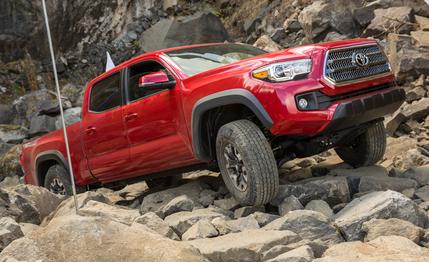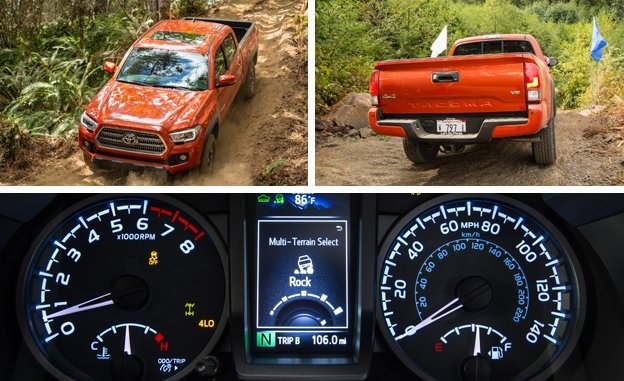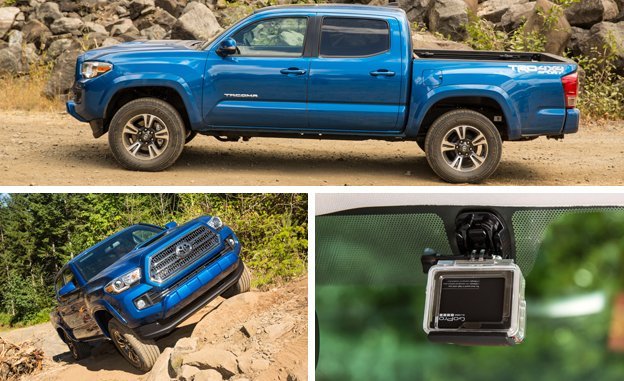
 First Drive Review
First Drive Review
It’s the gateway truck for a lifetime of truck addiction, the Americanized version of the world’s wheeled beast of burden, and precisely the right truck for carrying large dogs that shed. And the updated 2016 version of the Toyota Tacoma enters production hauling a birthright as the new small pickup that depreciates in value most slowly.
But it’s that deep Toyota truck legacy that’s holding the Tacoma back, too. Because Toyota has always been conservative and while this compact pickup is new, it’s not all new. Sometimes that’s not an advantage.
First, keep in mind that Toyota will peddle fully 29 versions of the new Tacoma. That’s a herd big enough to fill Seattle, one that ranges from a $24,200 Access Cab 4x2 SR work truck with a four-cylinder engine and manual transmission to a Double Cab 4x4 Long Bed Limited with a V-6 and six-speed automatic at $38,720. The average price is $31,768, and the version coming closest to that is the $31,665 TRD Sport Double Cab 4x2 with the V-6 and automatic transmission.
Gone from the line is the PreRunner name that had been used to indicate an insurance-friendly two-wheel-drive truck that looks like a 4x4. Instead, such trucks are now labeled as “TRD Sport” models. Confusing the issue, some TRD Sports will be 4x4s while the hardest-core 4x4s will be “TRD Off-Roads.” It’s the TRD Sport models that get the fake hood scoop.
In amid all those thinly sliced TRD Sport and TRD Off-Road and SR and SR5 and Limited variations there’s plenty of room to shove in some features that stake out new ground—a GoPro camera windshield mount is standard on all models!—but also plenty of carry-over from the Tacoma that was introduced as a 2005 model. The steel ladder frame and suspension underneath carries forward fortified and retuned but is unchanged in concept. That means there are control arms and coil springs in front and leaf springs in back whether or not the particular truck is equipped with four-wheel drive. And the shadow it casts hasn’t changed much.


Interestingly, Toyota has for some reason stuck with rear drum brakes on the new Tacoma. That’s despite the fact that the braking system otherwise incorporates some of the latest tech-buzzy systems like electronic brake-force distribution and brake assist. And both the Chevrolet Colorado and the Nissan Frontier use four-wheel discs across their lines.
Toyota explains that in this class of trucks, where whatever towing that goes on is light, braking force from the rear wheels is relatively unimportant. Which is true. Beyond that, the company asserts that drums have an advantage when off-roading because they’re sealed against rocks, mud, and other crud. That’s kind of pushing it.
As before, the Tacoma rides on either a 127.4- or 140.6-inch wheelbase depending on whether the particular truck is an extended Access Cab or crew-style Double Cab fitted with a choice of five- (60.5 inches) or six-foot (73.7-inch) beds. Toyota describes the Tacoma as mid-size, and that does distinguish it from the much smaller Toyota trucks from which it has evolved. But at 225.5 inches long overall, the longest 2016 Tacoma is actually only 3.4 inches shorter than the Toyota Tundra CrewMax we tested for a comparo earlier this year.
Toyota dumped the regular cab from the Tacoma line after 2014 due to a lack of demand. But beyond the fact that few customers seem to want regular-cab trucks anymore, the latest U.S. fuel-economy regulations are calculated according to “footprint”—which is to say the area of the rectangle determined by the four wheels’ hub centers. Larger footprints mean less severe mandates, and that pretty much dooms shorter-wheelbase trucks no matter what their cab design. If what you desire is a new regular-cab small truck, go find another dream.
In terms of styling, the shoulders of the front fenders now extend into the doors, the side windows are a bit shorter, there’s a new roof panel that accommodates a sunroof on the Double Cab, and the nose has been reshaped around a larger trapezoidal grille. But at first sight, the greenhouse appears unchanged. Structurally, there’s increased use of high-strength steel, and more sound-deadening material has been shoved into nooks and crannies. Altogether, the aesthetic is somewhat overwrought, but it’s instantly recognizable not only as a Toyota truck but as a Tacoma.
The big mechanical news is that the hoary, old 4.0-liter V-6 has been tossed, replaced by a new 3.5-liter, 24-valve DOHC V-6 that uses Toyota’s “D4S” combination of direct and port fuel injection similar to the system in the Scion FR-S and Subaru BRZ. Combined with more aggressive variable valve timing, it allows the engine to dance between Atkinson and Otto combustion cycles and produce 278 horsepower at 6000 rpm. That’s a robust 42 more horsepower than the outgoing 4.0-liter, but peak torque production drops by a single pound-foot to 265 (the peak moves up to 4600 rpm from 4000, too).
Meanwhile, the 2.7-liter four has limped into this program intact. That means 159 rather raucous horsepower and 180 lb-ft of torque at 3800 rpm. Four-cylinder engines don’t get much respect in this truck class, and adding insult to insult, the only manual transmission available with the four is a five-speed while the V-6 can be had with a new six-speed. Hey, it’s your own fault for going cheap.
Most buyers will opt for the new six-speed automatic transmission that Toyota has developed to work with either engine. With a direct 1:1 gear in fourth and two deep overdrives in fifth and sixth, the new transmission works peachy. But today many peaches carry seven, eight, or nine gears.


The new V-6 is sweet-natured and the new automatic well-behaved, but it’s the new interior that is the new Tacoma’s clearest improvement. The instrumentation is now contained inside a silver oblong structure that runs from the driver’s door past the dash center. Meanwhile a color-keyed pad sits ahead of the front passenger with four circular vents strewn across the dashboard. It all works fine, is easy to read, and the available entertainment options are extensive. And as expected in a Toyota, everything is executed in quality materials and assembled impressively well, at least in the preproduction trucks we drove.
Conceding all that, the front seats have rather short bottom cushions, and the rear seats in the Access Cab models are better used as parcel shelves than accommodating even the youngest mammals. The Double Cab models are more usable—and likely to make up more than 70 percent of Tacoma production—but the space back there isn’t expansive. If you’re looking to Uber with your Tacoma, don’t expect to earn many five-star ratings.
On road, the new Tacoma in any grade is quieter and easier going than previous versions. The ride motions are better controlled, the V-6 significantly more subdued, and the steering better mannered if not particularly communicative. This isn’t a sports car and it doesn’t pretend to be. Performance? Best guess has any V-6 model waltzing to 60 mph in about eight seconds.
Off the pavement, the TRD Off-Roads are impressive. The dual-range transfer case is easy to engage and there’s a Crawl Control system that acts as a sort of low-speed off-road cruise control, electronically operating the engine and brakes when surmounting serious obstacles. It works, even though you still have to steer. There wasn’t much chance to operate the “Multi-Terrain Select” system that optimizes the traction-control system for particular conditions. It probably works.
For a redesign that doesn’t redesign everything, the new Tacoma is a solid update. But looking forward, this market niche is likely to get only more competitive as the introduction of GM’s fresh compact trucks invites more entries. And will this Tacoma get a diesel option if the Canyon/Colorado twins attract buyers with their upcoming Duramax four-cylinder?
The Tacoma has owned its space for at least a decade. Now, suddenly, that space is worth watching.